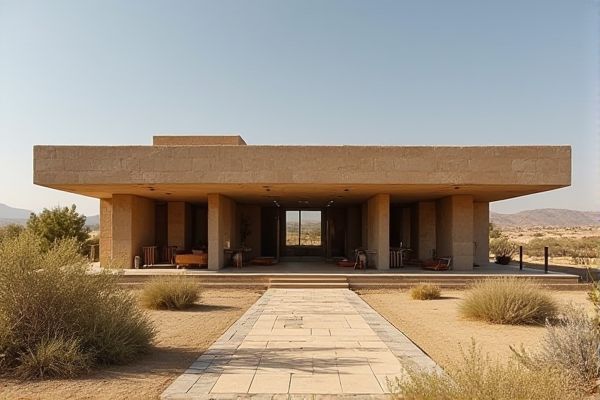
Ethiopia's architecture sector is experiencing growth, fueled by urbanization and infrastructure projects. Numerous opportunities exist within government agencies, private firms, and construction companies, focusing on sustainable design and urban planning. Graduates from architecture programs can find positions in residential, commercial, and public building projects. Networking through professional organizations and attending industry events can enhance job prospects in this evolving market.
Job Description
Architecture jobs in Ethiopia require a blend of creativity, technical skills, and knowledge of local building codes. Professionals in this field often engage in designing residential, commercial, and public structures, with an emphasis on sustainability and cultural relevance. Understanding the unique environmental challenges and materials available in Ethiopia is crucial for success in this role. You will collaborate with a variety of stakeholders, including clients, engineers, and contractors, to bring innovative designs to life while ensuring compliance with regulatory standards.
Requirement
Architecture jobs in Ethiopia often require candidates to possess a degree in architecture or a related field, along with relevant work experience in design and project management. Familiarity with local building codes, construction methods, and sustainable practices is crucial for successful candidates. Proficiency in software like AutoCAD and Revit is typically expected, enabling the creation of detailed architectural plans. Strong communication and teamwork skills are essential, as this role often involves collaboration with engineers, contractors, and clients throughout the project's lifecycle.
Salary and Perks Expected
Architecture jobs in Ethiopia offer competitive salaries that can vary based on experience, education, and the specific employer. Entry-level positions typically start at around 15,000 to 25,000 Ethiopian Birr per month, while skilled architects can earn between 30,000 to 60,000 Birr or more. Benefits often include health insurance, transportation allowances, and professional development opportunities, making these roles attractive for both local and international candidates. The growing demand for sustainable and innovative architecture in Ethiopia further enhances job prospects in this field.
Similar Job Names
- Architect
- Urban Planner
- Landscape Architect
- Interior Designer
- Project Manager
- Construction Manager
- Architectural Drafter
- Structural Engineer
- Civil Engineer
- Surveyor
- Building Inspector
- Design Consultant
- Urban Designer
- Lighting Designer
- Environmental Planner
Job Expectation Concept
Architecture jobs in Ethiopia demand a blend of creativity and cultural understanding, as professionals must design structures that reflect the nation's rich heritage while addressing modern needs. Employers typically seek candidates with a strong educational background in architecture, complemented by practical experience in local design practices and regulations. You should also be aware of the increasing emphasis on sustainable building practices, which aligns with global trends and local environmental goals. Networking within the Ethiopian architecture community and engaging with ongoing projects can enhance your career prospects in this evolving field.
Career Advantage and Weakness
Architecture jobs in Ethiopia offer unique career advantages, including the potential for meaningful contributions to urban development and infrastructure modernization. Professionals can engage in sustainable design practices that address local challenges and enhance community living standards. The rapid growth of cities creates a demand for skilled architects; however, competition for prominent projects can be fierce, limiting opportunities for newcomers. Economic fluctuations and resource shortages may also pose challenges, impacting project funding and stability in the architectural sector.
Important Thing Must Know
Architecture jobs in Ethiopia offer a diverse range of opportunities, driven by ongoing urbanization and development projects. You can find roles across various sectors, including residential, commercial, and infrastructure design, primarily in rapidly growing cities like Addis Ababa. The demand for skilled architects is increasing as the government prioritizes sustainable development and modern urban planning initiatives. A strong understanding of local materials, cultural context, and environmental challenges is essential for success in this field. Networking with industry professionals and obtaining relevant qualifications can significantly enhance your career prospects in Ethiopia's architectural landscape.
Alternative Career Options
Architecture graduates in Ethiopia can explore various alternative career options that leverage their skills and knowledge in design and planning. Opportunities in project management and urban planning allow you to apply your expertise to large-scale development projects and community initiatives. Roles in construction management also provide avenues to oversee building processes, ensuring that designs are executed efficiently and sustainably. Educational positions, such as teaching, enable you to inspire the next generation of architects while contributing to the advancement of architecture in the country.
Companies List
- Ethiopian Airlines
- Ministry of Urban Development and Construction
- Construction and Business Bank
- Africawide Consulting Architects
- Sur Construction
- Mott MacDonald
- ECA (Economic Commission for Africa)
- Addis Ababa University
- St. George's Brewery
- National Oil Ethiopia
List of Ideal City
Ethiopia offers a vibrant landscape for architecture jobs, particularly in cities like Addis Ababa, Hawassa, and Mekelle. Addis Ababa, the capital, features a blend of historical and modern architecture, making it a hub for innovative design projects. Hawassa is rapidly developing, with a growing demand for architectural services fueled by its expanding urban area. Mekelle, known for its unique construction styles, provides opportunities for those looking to contribute to sustainable and culturally relevant architecture.
 jobs-ethiopia.com
jobs-ethiopia.com